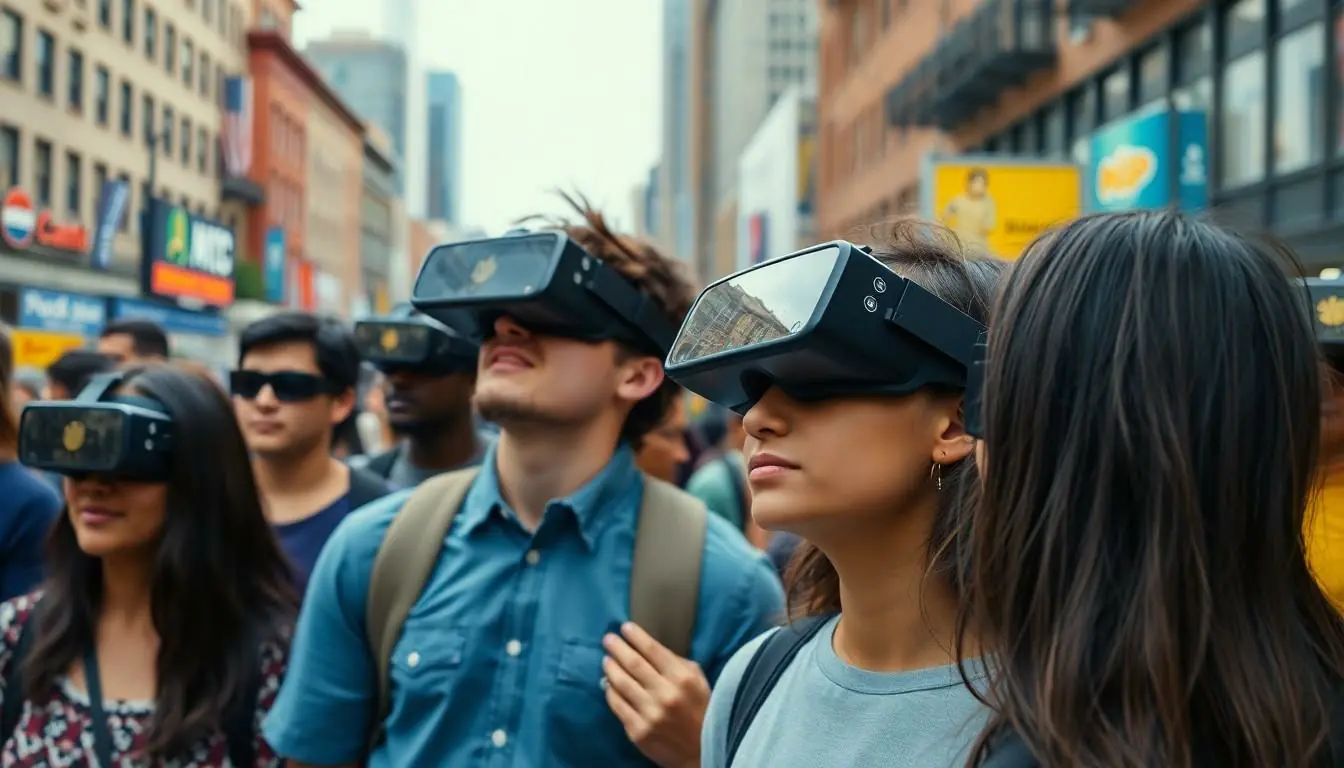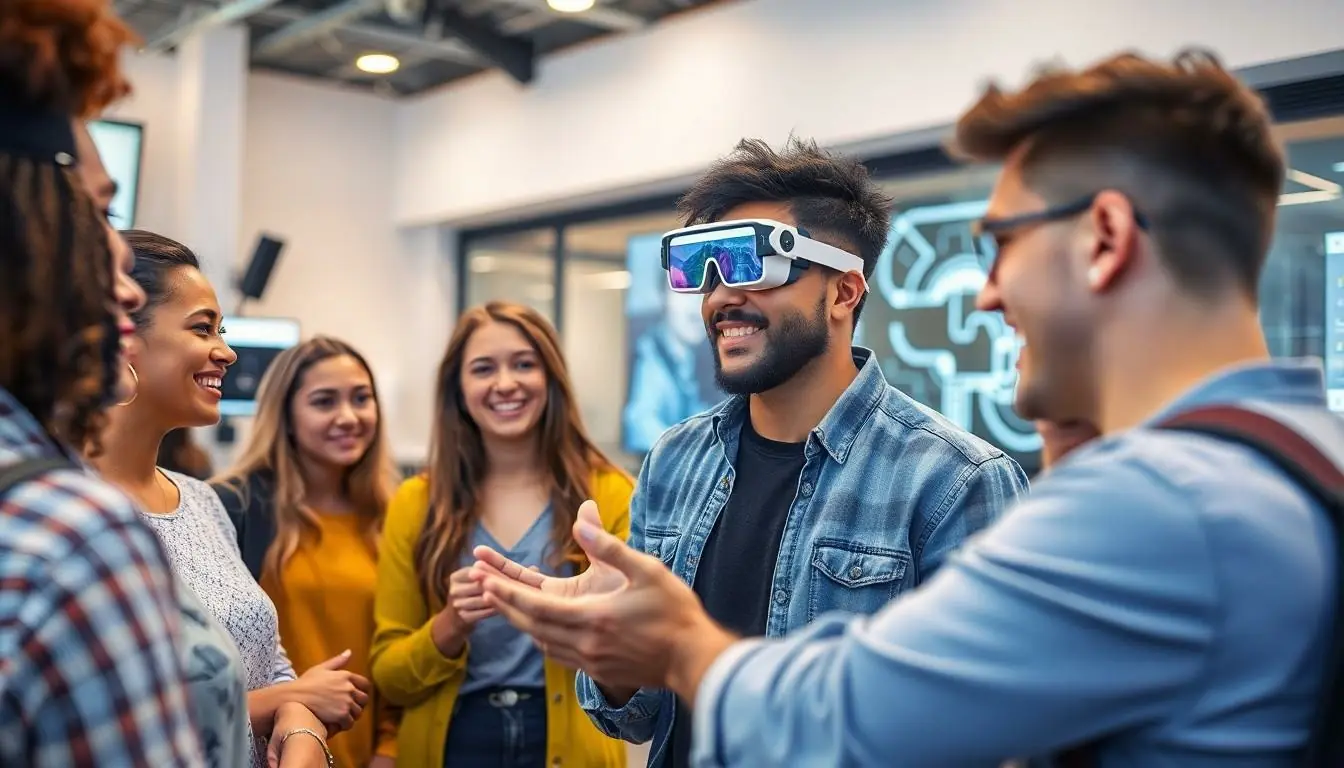In a world where technology evolves faster than a caffeinated squirrel, two acronyms have taken center stage: AI and AR. Artificial Intelligence, the brainy genius that learns and adapts, is often seen as the cool kid on the block. Meanwhile, Augmented Reality, the party animal that overlays digital magic onto our everyday lives, is ready to show everyone a good time.
Table of Contents
ToggleOverview of AI and AR
Artificial Intelligence (AI) and Augmented Reality (AR) represent cutting-edge technologies with distinct functionalities and applications. Both influence various aspects of daily life and industries.
Definition of AI
Artificial Intelligence refers to the simulation of human intelligence by machines. These systems process data, recognize patterns, and make decisions. With algorithms, AI models learn from experiences and improve performance over time. Examples include virtual assistants like Siri and advanced recommendation systems used by Netflix. AI’s ability to analyze vast datasets enhances productivity in fields such as healthcare, finance, and autonomous vehicles.
Definition of AR
Augmented Reality overlays digital information onto the real world, enhancing perceptions and interactions. This technology incorporates graphics, sounds, or GPS data within a user’s view. Users experience AR through devices like smartphones or AR glasses, which seamlessly integrate virtual elements into their surroundings. Popular applications include Pokémon GO and interactive marketing advertisements, showcasing AR’s potential to create immersive experiences in gaming, education, and retail.
Key Differences Between AI and AR

AI and AR serve distinct purposes, each contributing to technology in unique ways. Understanding their differences helps clarify their roles in modern applications.
Technology and Functionality
AI involves machine learning and algorithms to simulate human-like reasoning. This technology enables systems to analyze data, recognize patterns, and provide insights. In contrast, AR enhances the physical environment by overlaying digital content onto real-world views. This functionality engages users by integrating graphics and audio into their surroundings. While AI focuses on data processing and decision-making, AR centers on enhancing sensory experiences.
Use Cases and Applications
AI is widely used in personal assistants like Siri and chatbots that improve customer service efficiency. These applications of AI streamline processes in healthcare for diagnosis and finance for risk assessment. AR primarily finds its applications in gaming and marketing, as seen in Pokémon GO and dynamic ads. Education also benefits from AR via interactive lessons that provide immersive learning experiences. Both technologies hold transformative potential across various sectors.
Benefits and Limitations
Artificial Intelligence (AI) and Augmented Reality (AR) offer distinct advantages and face certain limitations. Understanding these aspects provides insight into their respective roles in modern technology.
Advantages of AI
AI enhances efficiency by automating repetitive tasks and analyzing vast data sets quickly. Businesses leverage AI for predictive analytics, improving decision-making processes significantly. Health care benefits from AI’s diagnostic capabilities, greatly enhancing patient outcomes. In finance, algorithms manage investments with precision. Furthermore, customer interactions improve through personalized experiences, thanks to AI-driven recommendation systems.
Advantages of AR
AR enriches user experiences by blending digital information with the real world. Gamers enjoy immersive experiences, such as those found in Pokémon GO, which encourage physical activity. Educational contexts benefit from AR through interactive lessons that engage students visually. Retailers utilize AR for product visualization, allowing customers to see items in their environments before purchasing. Event organizers create memorable experiences by integrating digital content into real-world events effectively.
Limitations of AI
Data privacy concerns arise with AI systems that process sensitive personal information. Algorithms can exhibit biases, leading to unfair outcomes. Dependence on data quality becomes crucial since inaccurate input affects AI reliability. High implementation costs in certain sectors may hinder widespread adoption. Furthermore, the lack of transparency in decision-making processes raises ethical questions about accountability.
Limitations of AR
User immersion can diminish if devices are bulky or uncomfortable to wear. Battery life limitations restrict prolonged usage of AR applications. Additionally, AR requires robust hardware and software for optimal performance, which may not be accessible to everyone. Technical glitches can interrupt experiences, leading to user frustration. Finally, AR’s reliance on internet connectivity can limit its effectiveness in areas with weak signals.
Future Trends in AI and AR
Innovation in AI and AR shapes their future. Emerging technologies drive the evolution of these fields rapidly.
Emerging Technologies
Quantum computing enhances AI’s data processing capabilities. By harnessing quantum bits, AI systems can analyze data exponentially faster than traditional computers. Machine learning algorithms also continue to improve, offering better prediction accuracy across various applications. AR development evolves with spatial computing, allowing more intuitive user interactions. With advancing hardware like light field displays, AR experiences become more immersive. The Internet of Things combined with AI fosters smart environments that adapt to individual preferences. These advancements streamline tasks and elevate user experiences significantly.
Potential Market Impact
Market potential for AI and AR shows promising growth. According to industry reports, the global AI market could reach $190 billion by 2025. AR market forecasts predict a valuation of approximately $198 billion within the same timeframe. Businesses leverage AI to enhance customer service, resulting in higher customer satisfaction and loyalty. Retailers increasingly adopt AR for virtual try-ons, driving sales through innovative shopping experiences. Improvements in these technologies can transform industries, from healthcare diagnostics to entertainment. Increased investment in research and development ensures continuously evolving applications, ultimately reshaping the market landscape.
AI and AR are transforming how people interact with technology and their environments. As AI continues to refine decision-making and automate tasks, AR enhances experiences by merging digital content with the physical world. The interplay between these technologies is paving the way for innovative solutions across various sectors.
Looking ahead, both AI and AR are set to grow significantly, driven by advancements in machine learning and spatial computing. This evolution will likely lead to new applications that further enrich user experiences and streamline processes. Embracing these technologies can provide businesses with a competitive edge in an increasingly digital landscape.

